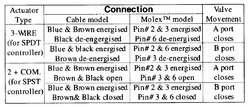I'm hoping keyman or elk or one of you other wiring wizzards can walk me through the process of wiring up a three-way zone valve. I have a spec sheet for the valve, but nothing for the Honeywell Class 2 transformer, other than a sticker on the side listing the load capacities for the various wires. I can probably dope this out on my own, but figure it doesn't hurt to check with somebody who actually knows what they're talking about.
OK, so all I want to do is take 120v current from an aquastat and use it to activate the zone valve. On the transformer, it identifies the wires as follows:
Primary:
BLK (com)
WHT 120V
RED 208V
ORG 240V 60HZ
Secondary
BLUE-YEL 24VAC 40VA
Since the aquastat is just a switch, I'll have a 120V black wire running from it to the transformer. I'll have a 120V white wire going directly back to the breaker panel. Do I connect the black wire on the thermostat to the black wire feed coming from the aquastat and the white to the white?
Presumably, the blue and orange 24V wires connect to the zone valve. Let's tackle that connection once I'm clear on the 120V side.
OK, so all I want to do is take 120v current from an aquastat and use it to activate the zone valve. On the transformer, it identifies the wires as follows:
Primary:
BLK (com)
WHT 120V
RED 208V
ORG 240V 60HZ
Secondary
BLUE-YEL 24VAC 40VA
Since the aquastat is just a switch, I'll have a 120V black wire running from it to the transformer. I'll have a 120V white wire going directly back to the breaker panel. Do I connect the black wire on the thermostat to the black wire feed coming from the aquastat and the white to the white?
Presumably, the blue and orange 24V wires connect to the zone valve. Let's tackle that connection once I'm clear on the 120V side.



